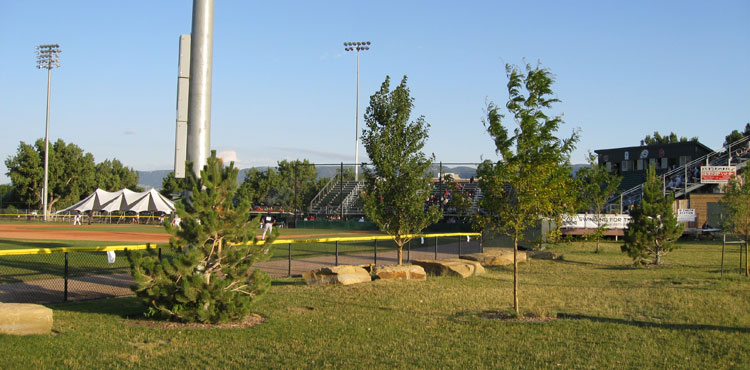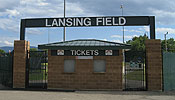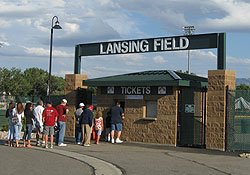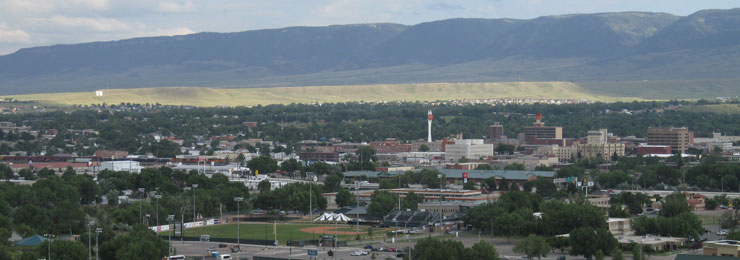
|
Seeing a game at Mike Lansing Field reminds me of the song “Wide Open Spaces” by the Dixie Chicks. Granted, Natalie Maines croons specifically about someone of her own gender when she signs, She needs wide open spaces; Room to make her big mistakes.
But just like the protagonist in the song, which was written by a Montana college student, many a young man’s dreams first take shape in a place out West, where Casper, Wyoming is the first stop on the journey to the major leagues for players in the Colorado Rockies organization. The majority of players on the Casper Ghosts’ roster are new faces in the high stakes game of professional baseball and they play in a ballpark with plenty of wide open spaces, one where too many big mistakes could end the pursuit of their dream, which has a final destination of Denver, a 275 mile drive south down I-25. The path to Coors Field begins at a ballpark named after one of the Rockies’ former players, Mike Lansing, for no other reason than he grew up in Casper. So did former big leaguers Mike Devereaux and Tom Browning, who threw a perfect game, but it is Lansing, who was actually born in Rawlins, WY, that was forever immortalized in the city where he first achieved athletic notoriety when the only pro ballpark in the United States’ least populated state opened in 2002. Appropriately, when it comes to seating capacity Mike Lansing Field is one of the smallest ballparks to be used on the pro level, as its grandstand has space for a mere 2,500 folks. Yet its playing field is spacious; the elongated distances to the foul poles (355’ to left and 345’ to right) help offset the ballpark’s elevation of 5,150 feet above sea level. The small grandstand and larger than average plot of land needed for the field make the ballpark seem even smaller than it is and, as a result of those two factors, wide open spaces are in abundance across the land that comprises the ballpark’s footprint.
From that entrance point a wide paved walkway leads to the grandstand, which is comprised of three freestanding aluminum sections of seating and an aisle that separates them from the three continuous rows of field level seating that are erected atop concrete. The interior aisle runs from dugout to dugout. Seats below it and in the section behind home plate are of the traditional plastic-molded stadium seat variety and have cup holders. The larger sections of seats on the first and third base sides of the park are comprised exclusively of bleachers, the lower half with backs and the upper half without backs. The ballpark is open-ended beyond both dugouts and has no suites, although it does have two leather recliners on the first base aisle that are reserved for winners of a promotion. Behind both dugouts are wooden decks, referred to as the Teton Terraces, from which a variety of draft beers are served. To buy one a fan must visit the ID check station in front of the third base deck. Upon each deck are a few high top bar tables but the main draw is the drink rail and bar stools placed directly behind each dugout. Space on the Teton Terraces is first-come, first-served, but the ballpark does have one area that can be reserved by groups of 25 or more. That would be down the right field line, where a tent covering numerous picnic tables resides. It is strategically placed next to what the team refers to as their “outdoor kitchen,” which primarily serves traditional ballpark meats from a grill. The single permanent concession stand behind home plate is covered and is the only place in the ballpark besides the press box with a roof over it. The ballpark’s main concourse is behind the grandstand, obscured from the playing field. An information booth and specialty concession stands are clustered together behind the third base grandstand. The majority of “stuff” is placed on the concourse's third base side, highlighted by the team store that is built into the exterior walls, which are made of a light brown-colored brick. Placed upon the wall near the team store are separate dry erase boards listing the line-ups and Pioneer League standings. Next to them is a sign that reads "Home of Casper Legion Baseball" and a list of the 19 years that Casper's American Legion teams have won the state championship. The Legion teams are co-tenants with the Ghosts at Mike Lansing Field and receive equal billing on the ballpark's roadside entrance sign. The concourse continues to the end of the first base grandstand, where inflatable games are set up for kids. Beyond that are the clubhouses for both teams and gravel walking paths that lead to the covered picnic area. A paved path connects the home team bullpen to the clubhouses. Pitchers heading in that direction during the game pass through a weathered grass field that is favored by youths burning off some energy. A very weathered infield – modeled after the half-fields you see in spring training – sits neglected by players and ground crew in the right field corner near two batting cages that fans can wander up to.
The person most responsible for livening up the atmosphere at the ballpark is the individual who wears the purple platypus costume and goes by the name Hobart. So why is a semi-aquatic mammal endemic to eastern Australia a mascot for a team in Wyoming? The answer is because Casper is on the North Platte River. Get it? Platte, platypus. Neither did I. The name Hobart comes from the capital of Tasmania, where most platypuses are found. Hobart the mascot is purple because that’s one of the Rockies’ primary colors and he’s as ubiquitous and loved at Mike Lansing Field as the Bucking Horse and Rider logo is throughout the state of Wyoming. Hobart has been the team’s mascot since they began playing at Mike Lansing Field in 2002 as the Casper Rockies. For marketing purposes the team changed its name to the Casper Ghosts in 2008. That name was inspired, of course, by Casper the Friendly Ghost, but the team’s primary logo is a fierce-looking ghoul that doesn’t look anything like the popular animated cartoon character that was created in the 1930s. The owners of the friendly ghost image, however, did grant the Ghosts baseball team permission to use the iconic image as an alternate logo, but it’s the ghoulish version that gained much publicity when it was introduced. That’s because Minor League Baseball allowed the team to wear (and of course market) glow-in-the-dark caps sporting that logo. They are sold in the team shop and at a specially created website, CasperGhostsGear.com, the team operates. While their logo is grandiose, the Ghosts’ ballpark is much more basic. That includes the scoreboard, a simple and small thing without much more than a line score that peeks over the wall in left-center. Not too far beyond left field is a hill that dominates the ballpark’s backdrop. At the apex of the hill is the Casper Events Center, a 8,395-seat multi-purpose arena that opened in 1982 and hosts concerts, plays and the Wyoming Cavalry arena football team. Trees frame the playing field and they are known to sway in the whipping winds that the area is noted for. In fact, a game in 2004 was halted because of 60 MPH gusts. Plenty more stories like that can be told by local fans, who live in a state populated by “wind farms,” which generate electricity through the use of turbines. A total of 11 poles are used to support the backstop in front of the grandstand. All seats are behind it and the supports do slightly obstruct various parts of the playing field depending on where you sit. Attached to a few of the backstop’s supports are speakers, a placement that ensures audio quality is crisp since sound doesn’t have to travel very far to reach fans in the stands. Not all fans enjoy the ballgame from the grandstands. Quite a few congregate in the open space down the left field line. Most stand behind the chain link fence but others choose to sit or stand atop the flat rocks near the third base dugout. At the game I attended one enterprising local fan brought in a portable folding chair to enjoy the game from his favorite rock, each of which are wide enough to support a few fans. Besides rocks, the area is spruced up with spruce trees and the Mikel Stamper memorial bench, which is made of stone and inscribed with “loved to play the game.” Stamper died in 2005 at the age of 22. Former Casper players are remembered and tracked on a dry erase board affixed to the concourse’s exterior wall on the first base side of home plate. The Alumni Board lists a handful of former Ghosts and their current stats at other destinations in the Rockies' organization. Unlike most ballparks, the dedication plaque for Mike Lansing Field is not attached to an exterior wall. Instead it’s slanted atop a stand in the tree and rock-filled field down the left field line, part of the most naturally appointed wide open space you’ll ever see at a ballpark. While it won’t ever create the uproar that the Dixie Chicks have, Mike Lansing Field takes to heart the title of the group’s breakthrough song. It's a quaint and windy place to watch a ballgame and just like the state of Wyoming it has plenty of wide open spaces.
Location and ParkingMike Lansing Field is less than a mile east of I-25, from which you exit at Poplar Street. That street takes you directly to the ballpark, which anchors Casper’s recreation center. The spot is a popular year-round destination thanks to the Platte River Parkway trail, a paved path that runs parallel to the North Platte River. The pedestrian parkway is between the right field wall and the North Platte River, which is literally in the shadows of the ballpark. A playground for kids is even closer to the ballpark than the river is and four ball fields (three softball, one baseball) nearby are used by local all-ages rec teams. Although Casper is a small town it’s large by Wyoming standards. With about 50,000 residents it’s the second biggest city in the state, barely bested by the state capital in Cheyenne that is 180 miles to the south. Much of what there is to do in Casper is near Mike Lansing Field, which is close to numerous chain hotels. Those hotels dominate the backdrop for fans on the ballpark's first base side, as they are clearly visible beyond the open area on the opposite side of the ballpark. The one building visible from anywhere within Lansing Field is the Casper Events Center. The hilltop arena sports a red awning roof that makes it look more like an oversized church. Near the arena is the National Historic Trails Interpretive Center, which is managed by the U.S. Department of the Interior and has interactive exhibits and a multimedia presentation about the settlement of the West. All parking at the ballpark is free. A large paved lot extends from the Poplar Street entrance to behind the left field wall. A small semi-circle area in front of the ticket office makes it possible to drop off elderly or disabled fans at the ballpark’s entrance gate.
HistoryWhen the Butte (MT) Copper Kings relocated to Casper in 2001 it was with the intention of starting anew in a new stadium. But delays forced the team to play their inaugural campaign in Wyoming in George Tani Field, a 1964-built ballpark with cozy dimensions (313' to left, 312' to right) and a history of hosting amateur baseball. Casper’s new ballpark was ready to go by the time the 2002 Pioneer League season began, although the first baseball game played there took place on May 12th of that year when the Casper Oilers hosted the Billings Royals in an American Legion contest. The following month, on June 21, the Casper Rockies made their debut at their new home field with Mike Lansing himself on hand for dedication ceremonies. In an ironic twist, Lansing's 13-year career ended the same month the ballpark bearing his name opened. With the opening of Mike Lansing Field professional baseball finally had a permanent home in the state of Wyoming. Prior to the Casper Rockies/Ghosts there had been only one season of pro ball ever played in the state, and that occurred all the way back in 1941 when the Cheyenne Indians of the Class D Western League went 59-44. That league, like many others, was shut down the following year due to World War II and minor league baseball wouldn’t return to Wyoming for another six decades.

Mike Lansing Field Footnotes
| |||||||||||||||||||||||||||||



 With abundant free parking on paved spaces found behind left field, all fans enter the ballpark through its single entrance adjacent to the left field foul pole. That’s where the ticket office resides. The small brick building has but two ticket windows and pillars on each side of it that support a sign that says “Lansing Field.”
With abundant free parking on paved spaces found behind left field, all fans enter the ballpark through its single entrance adjacent to the left field foul pole. That’s where the ticket office resides. The small brick building has but two ticket windows and pillars on each side of it that support a sign that says “Lansing Field.”
 The ballpark’s most innovative, or at least unique, feature is an oversized mural that hovers behind the right field wall. The mural is called the "Big Catch" and shows two kids - a girl and a boy - watching the game while fishing into the North Platte River, which is a handful of feet beyond the wall. The mural was dedicated on June 18, 2004. It was produced by John Cerney, a California-based artist who specializes in making "giant cut-out art." His work at Lansing Field measures 20 feet tall and was commissioned to "liven up the atmosphere of the park," which it would do a better job of if didn’t look like an extension of the ads that cover the outfield wall.
The ballpark’s most innovative, or at least unique, feature is an oversized mural that hovers behind the right field wall. The mural is called the "Big Catch" and shows two kids - a girl and a boy - watching the game while fishing into the North Platte River, which is a handful of feet beyond the wall. The mural was dedicated on June 18, 2004. It was produced by John Cerney, a California-based artist who specializes in making "giant cut-out art." His work at Lansing Field measures 20 feet tall and was commissioned to "liven up the atmosphere of the park," which it would do a better job of if didn’t look like an extension of the ads that cover the outfield wall.

